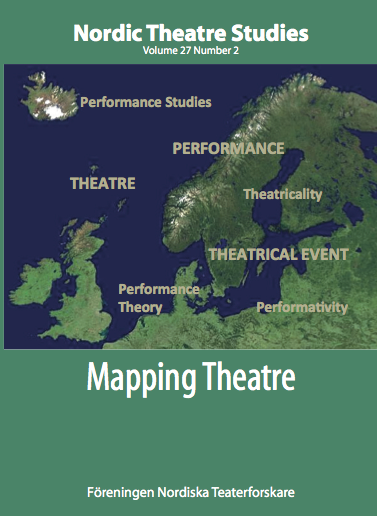Meaning in the Weaving: Mapping and Texture as Figures of Spatiality and Eventness
DOI:
https://doi.org/10.7146/nts.v27i2.24247Keywords:
dramaturgy, ecology, metaphor, texture, weaving, Tim Ingold, Stephen C. PepperAbstract
Advocating a dramaturgical ontology of events rather than objects – or ecologies rather than cartographies – the article defends the metaphors of texture and weaving as intuitive, non-anthropocentric alternatives to current idioms of becoming and emergence. Already popularized as the very definition of “dramaturgy” by Eugenio Barba, these are specifically traced through Tim Ingold’s recent anthropology of weaving and S. C. Pepper’s philosophical pragmatism: where Ingold’s ecology of lines admits to “no insides or outsides [...] trailing loose ends in every direction”, Pepper’s “contextualistic world” of events admits “no top nor bottom” to its strands and textures. Intended only as a theoretical introduction to the implications of a certain family of metaphors (complete with a graphic representation thereof ), this article distinguishes the eventness of texture from certain notions of spatial “mapping” and discusses the “ecological” range of the metaphor through the concepts of textural fusion and spread.References
Eugenio Barba, On Directing and Dramaturgy. Burning the House, Routledge, London, New York 2010.
Eugenio Barba, “The Nature of Dramaturgy. Describing Actions at Work” in New Theatre Quarterly, vol. 1, no. 1, 1985.
Eugenio Barba, “An Amulet Made of Memory. The Significance of Execises in the Actor’s Dramaturgy” in The Drama Review, vol. 41, no. 4, 1997.
Bruce Barton, “Interactual Dramaturgy. Intention and Affect in Interdisciplinary Performance” in The Routledge Companion to Dramaturgy, Routledge, London, New York 2014.
Sharon Marie Carnicke, Stanislavsky in Focus, Routledge, London, New York 2008. Robert Cooper and Stephen Fox, “The ‘Texture’ of Organizing” in Journal of Management Studies, vol. 27, no. 6, 1990.
Tim Etchells, “Doing Time” in Performance Research, vol. 14, no. 3, 2009. Silvia Gherardi, Organizational Knowledge. The Texture of Workplace Learning, Blackwell, Malden, MA 2006.
Richard Harper, Texture. Human Expression in the Age of Communications Overload, The MIT Press, Cambridge, MA 2010.
Tim Ingold, Lines. A Brief History, Routledge, London, New York 2007.
Tim Ingold, The Perception of the Environment. Essays in Livelihood, Dwelling and Skill, Routledge, London, New York 2000.
Tim Ingold, The Life of Lines, Routledge, London, New York 2015.
Tim Ingold, Being Alive. Essays on Movement, Knowledge and Description, Routledge, London, New York 2011.
Tim Ingold, Making. Anthropology, Archaeology, Art and Architecture, Routledge, London, New York 2013.
Claire MacDonald, “Conducting the Flow. Dramaturgy and Writing” in Studies in Theatre and Performance, vol. 30, no. 1, 2010.
Doreen Massey, For Space, Sage, London 2005.
J. Hillis Miller, Ariadne’s Thread. Story Lines, Yale University Press, New Haven 1992.
Gareth Morgan, Images of Organization, Sage, Thousand Oaks 1997.
Edward K. Morris, “Some Reflections on Contextualism, Mechanism, and Behavior Analysis” in Psychological Record, vol. 47, no. 4, Fall 1997.
Timothy Morton, The Ecological Thought, Harvard University Press, Cambridge, MA 2010.
Stephen A. Norwick, The History of Metaphors of Nature. Volume I. Science and Literature from Homer to Al Gore, Edwin Mellen, Lewiston 2006.
Teemu Paavolainen, “Textures of Thought. Theatricality, Performativity, and the Extended/Enactive Debate” in The Cognitive Humanities: Embodied Mind in Literature and Culture, Peter Garratt, ed., Palgrave Macmillan, Basingstoke (forthcoming).
Teemu Paavolainen, “Woven Within. Textures of Theatricality and the Directorial Impulse” in Tekijä. Teos, esitys ja yhteiskunta. Näyttämö & tutkimus 6, Annette Arlander, Laura Gröndahl, Helka-Maria Kinnunen, Marja Silde, eds, Teatterintutkimuksen Seura, Helsinki (forthcoming)
Teemu Paavolainen, Theatre/Ecology/Cognition. Theorizing Performer-Object Interaction in Grotowski, Kantor, and Meyerhold, Palgrave Macmillan, New York 2012.
Mike Pearson, Site-Specific Performance, Palgrave Macmillan, Basingstoke 2010.
Mike Pearson and Michael Shanks, Theatre/Archaeology, Routledge, London, New York 2001.
Stephen C. Pepper, World Hypotheses. A Study in Evidence, University of California Press, Berkeley, CA 1984 [1942].
Dassia Posner, “The Dramaturg(ies) of Puppetry and Visual Theatre” in The Routledge Companion to Dramaturgy, Routledge, London, New York 2014.
Magda Romanska, “Introduction” in The Routledge Companion to Dramaturgy, Routledge, London, New York 2014.
Chris Salter, Entangled. Technology and the Transformation of Performance, The MIT Press, Cambridge, MA 2010.
Willmar Sauter, The Theatrical Event. Dynamics of Performance and Perception, University of Iowa Press, Iowa City 2000.
Richard Schechner, Between Theater & Anthropology, University of Pennsylvania Press, Philadelphia 1985.
Peter Stockwell, Texture. A Cognitive Aesthetics of Reading, Edinburgh University Press, Edinburgh 2009.
Cathy Turner, Synne K. Behrndt, Dramaturgy and Performance, Palgrave Macmillan, Basingstoke 2008.
Downloads
Published
How to Cite
Issue
Section
License
The copyright belongs to the authors and Nordic Theatre Studies. Users can use, reuse and build upon the material published in the journal but only for non-commercial purposes. Users are allowed to link to the files, download the files, distribute the files on a local network (preferably by links), upload the files to local repositories if their institutions require them to do so, but not republish the files without proper agreements with the journal and the author.

